Roast Chicken Recipe
This roast chicken is so flavorful and juicy you’ll never believe how easy it is to make. It’s seasoned generously and stuffed with lemon, garlic, and herbs for delicious flavor inside and out. Outside, there is more seasoning and a coat of flavored butter.
If you like cooking a whole chicken, try my Spatchcock Chicken or break it down and make Chicken Fricassee.
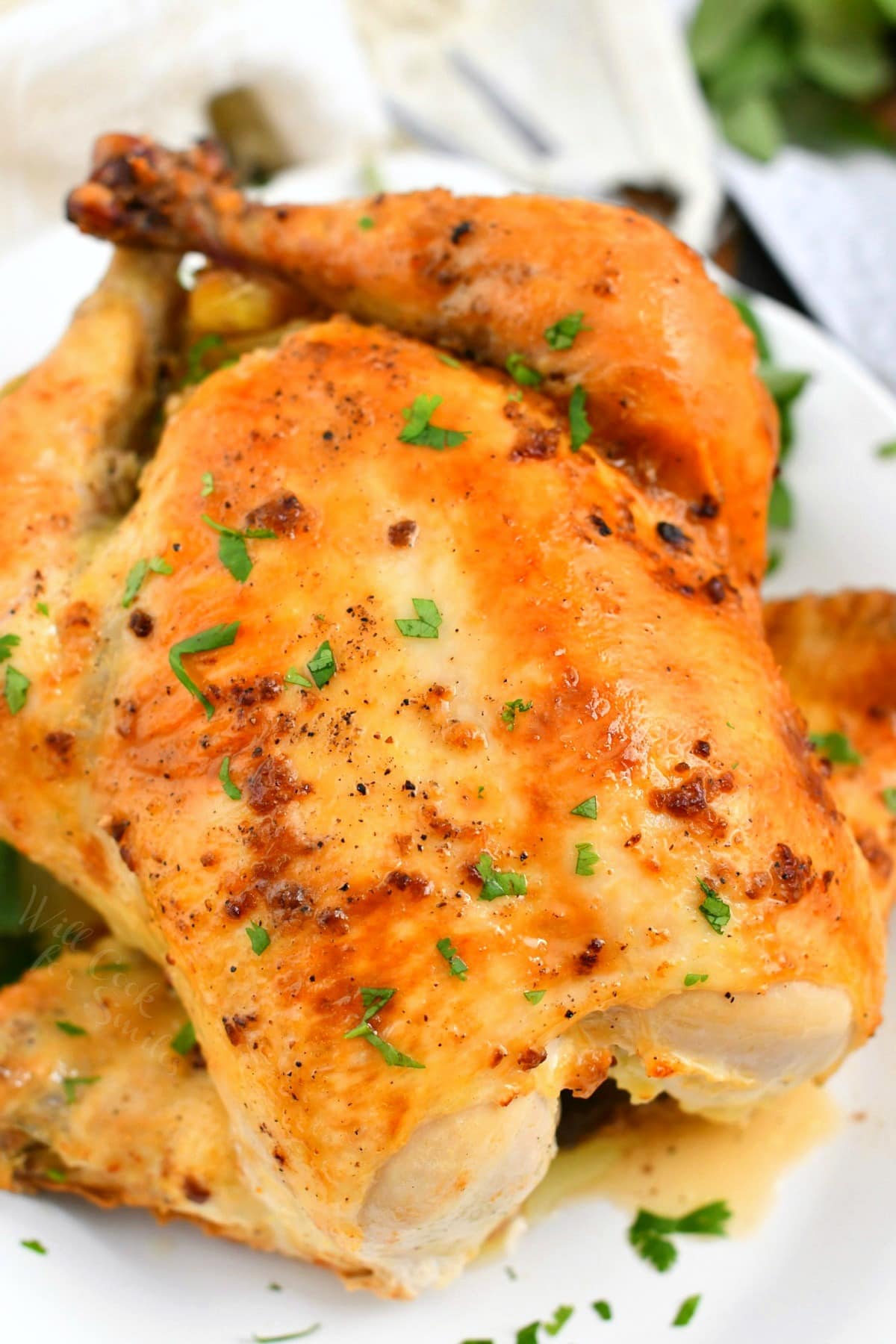
Table of Contents
A roasted chicken with golden, crispy skin and juicy, tender meat makes the perfect meal for any occasion. It’s a classic Sunday dinner perfectly paired with sides of fluffy mashed potatoes, roasted vegetables, and homemade potato dinner rolls.
If roasting a whole chicken seems a little scary to you, don’t be afraid! It’s very easy to make and doesn’t require much effort beyond preparing the chicken. The meat comes out so tender and juicy, you’ll want to have more and more. And if you have any leftovers, make some chicken noodle soup, casseroles, or chicken salad.
A whole chicken is usually cheaper to get at the store than getting pieces already broken down. I also like working with a whole chicken because I can satisfy everyone at one, those who prefer the breast meat and those who like the dark meat. When you see a nice chicken on sale, make sure to grab it! There are so many recipes you can make with it, besides just roasting it.
Tips For Juicy Oven Roasted Chicken
1-Bring the meat to room temperature before cooking. Cooking any type of meat while it’s cold will result in uneven cooking, which could be undercooking, overcooking, or both at the same time. For the best results, remove the meat from the fridge and leave it at room temperature for 45-60 minutes before roasting.
According to USDA food safety guidelines, as long as the temperature of the room is below 85°F and the chicken doesn’t stay out for longer than 2 hours, it is perfectly safe to use.
2-Use a large roasting pan with high sides when possible. In order for the meat to cook evenly, heat needs to circulate all the way around it. So, you have to use a pan that is large enough to fit the chicken. Also, a pan with high sides ensures that the heat stays closer to the roasting chicken.
3-Cook according to internal temperature, not by time!
There are many factors that can effect the cook time of the chicken, like size of the chicken and oven temperature. So it’s very important not to roast chicken by time alone. Use a digital instant-read cooking thermometer to determine when it’s done. Chicken is safe to eat when the internal temperature of the thickest part of the breast or thigh reaches 165°F.
4-Allow the meat to rest before carving. After removing chicken from the oven, it’s important to allow the juices to redistribute back into the meat. Otherwise, when you slice into the meat, the juices will end up on your cutting board.
5-Preheat the oven. This is another common mistake. The oven needs to be hot enough to start the roasting process. So make sure to preheat your oven to 425°F before placing the meat inside.
Ingredient Notes
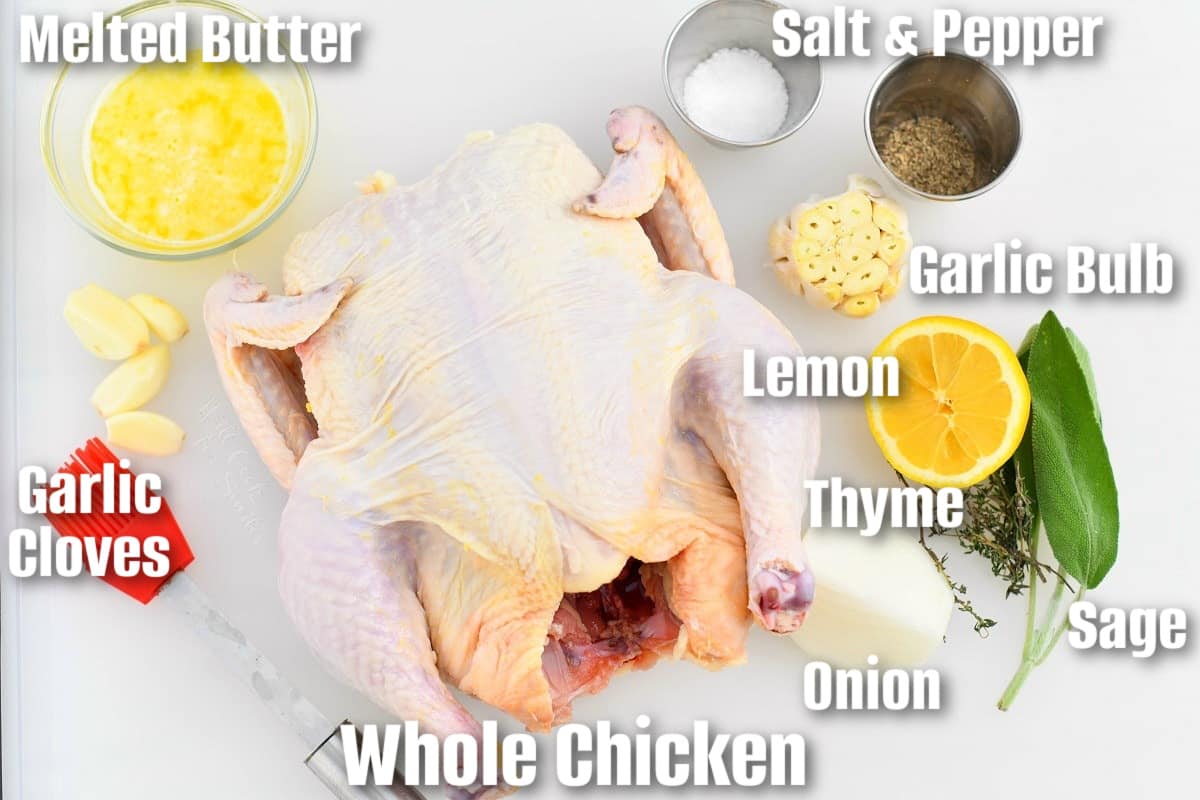
Whole Chicken – get the chicken that is between 4 and 6 lbs. and make sure it is completely thawed before starting to cook.
Butter – use unsalted butter. Since you are salting the inside and outside of the chicken, unsalted butter will help control the amount of sodium.
Garlic – you will need a whole bulb to stuff the chicken and some cloves for the seasoning of the outside.
Seasoning – remember to season the inside of the cavity with salt and pepper and you will also need some for the outside.
Herbs – using fresh herbs will give you more aromatic results and help with overall flavor of the chicken.
See recipe card for complete information on ingredients and quantities.
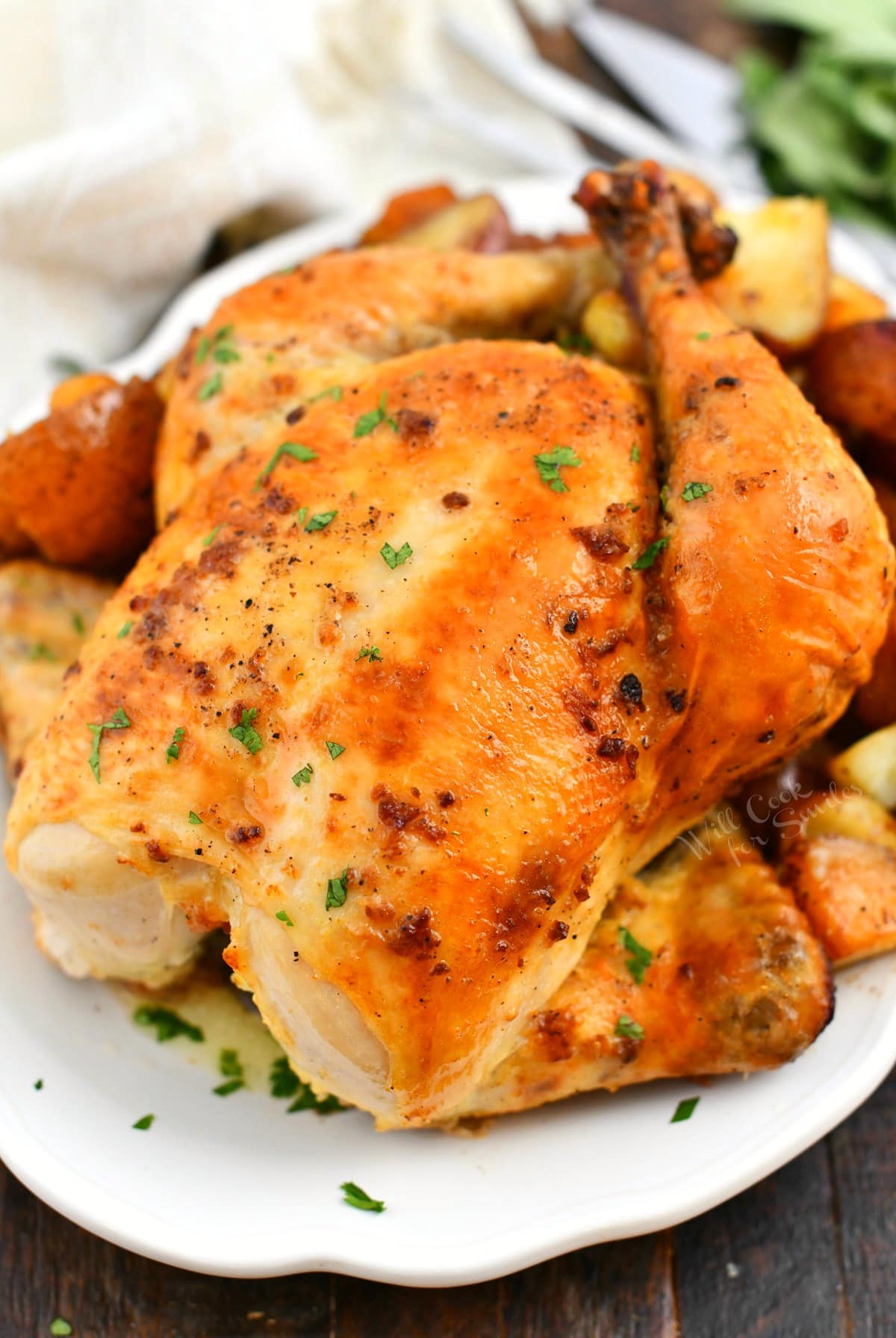
How To Make Roast Chicken
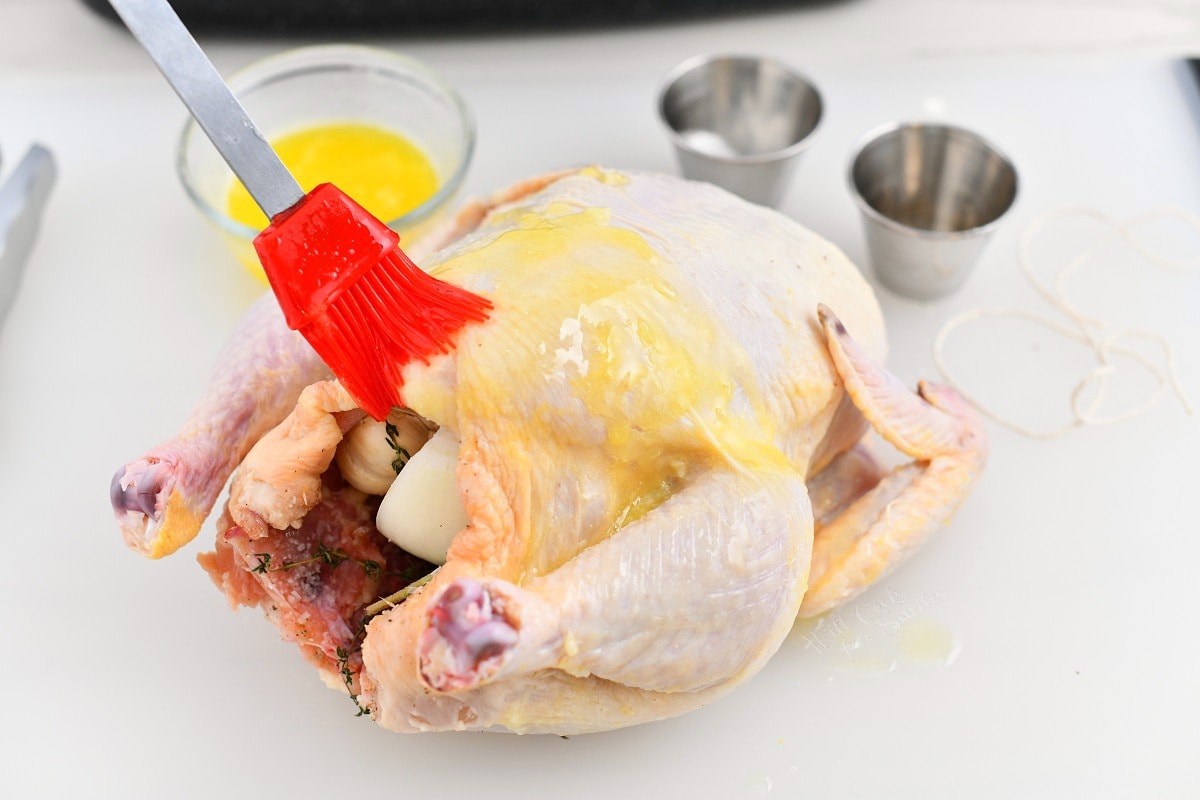
PRO TIP: For easier cleanup, line your roasting pan with a sheet of aluminum foil.
Preheat oven to 425°and prepare roasting pan.
Prepare the chicken for roasting: Clean it first. Take the chicken out of the package and use paper towels to dry it off. Be sure to check the cavity for giblets and neck. You can discard them, or use them to make chicken stock.
Apply seasoning: Use your fingers to apply salt and pepper all over the inside of the cavity. Don’t be afraid, give it a good amount of seasoning.
PRO TIP: To infuse more flavor, remember to season well inside the cavity.
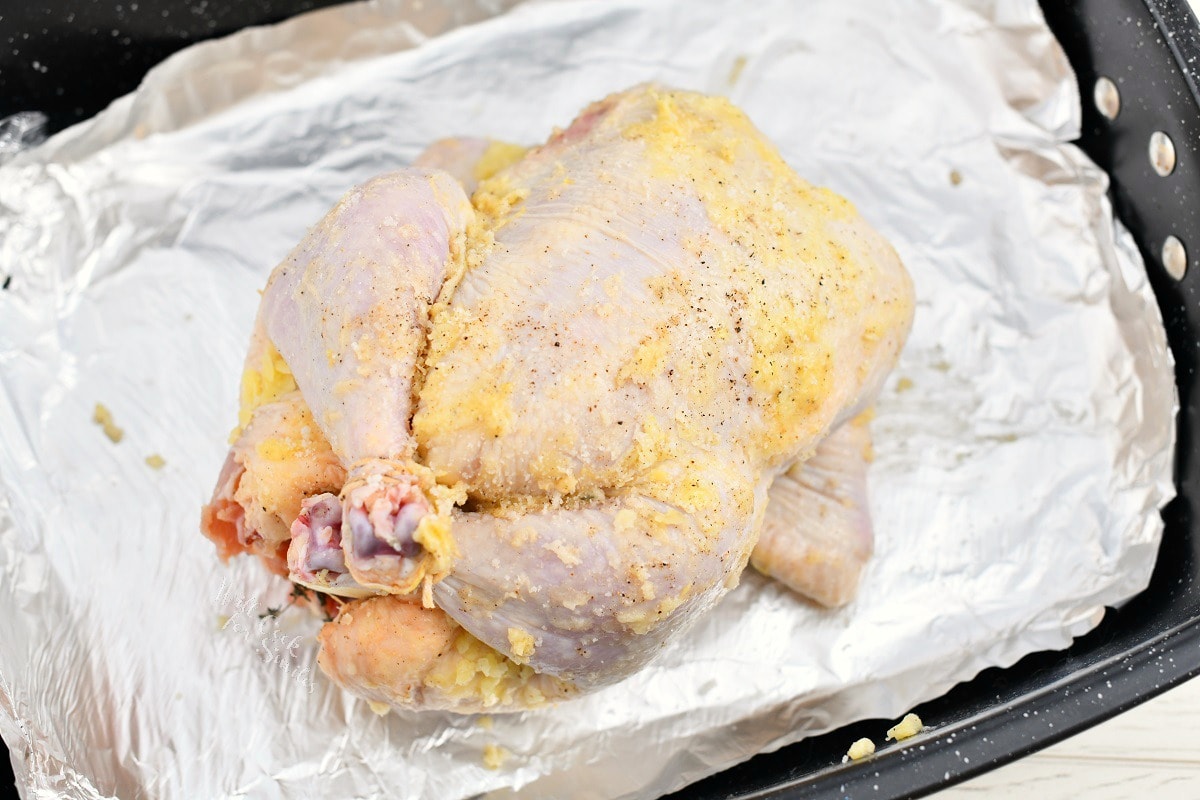
Then, insert half a lemon, quarter of an onion, garlic bulb, sage, and thyme into the cavity. Next, use cotton twine to tie the legs together.
In a small bowl, combine melted butter and pressed garlic cloves. Brush the entire outside surface with garlic butter, then generously season the outside with salt and pepper.
Bake: Place the chicken into the prepared roasting pan and then transfer it to the oven. Bake chicken for 80 to 90 minutes, or until the juices run clear and the temperature in the center of the breast at the thickest part reaches 165°F.
NOTE: Due to carryover cooking, chicken continues to cook for another 2 to 5 degrees after you remove it from the oven.
Allow it to rest. Take the chicken out of the oven and transfer it to a carving board. Tent it loosely with a sheet of foil and let it rest for 10-15 minutes.
PRO TIP: It’s important to let meats rest after cooking so that the juices that have condensed during the cooking process have a chance to redistribute back throughout the meat.
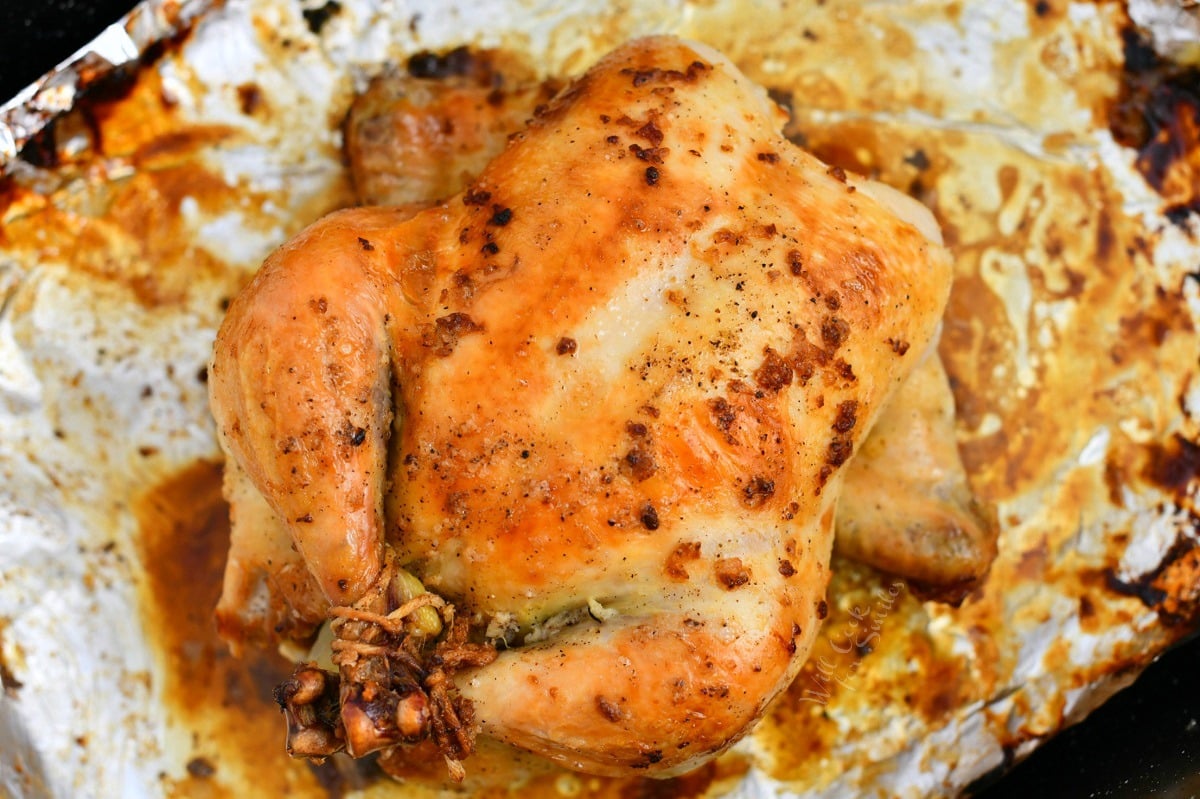
Recipe FAQs
When it comes to meats, don’t try to guess if the meat is done just by the cooking time. Cook time always varies! It’s always best to use a meat thermometer!
It’s the most certain way to make sure the meat is fully cooked. Remember to inserted the probe into the thickest part of the meat, fully cooked chicken that’s safe to eat should be 165°F.
While both of these methods involve cooking with dry heat in an oven, the primary difference is the cooking temperature.
Baking temperatures are at or below 375°F, while roasting requires high heat cooking of at least 400°F. Higher temperature is necessary to brown the food, and to create crispy skin.
After testing different temperatures through the years, I find 425° to be the best. And that goes for the whole chicken or other bone-in chicken cuts. At this temperature, you get a wonderfully juicy chicken with crispy skin.
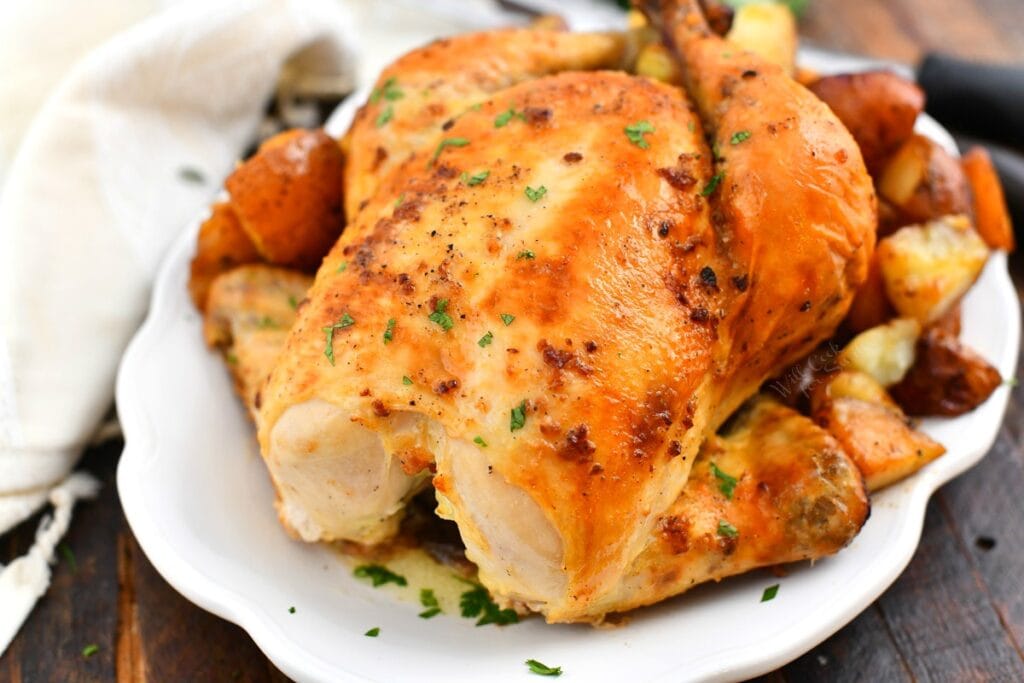
Adding Vegetables While Roasting Chicken
When you make the roast chicken recipe, you can add vegetables right into the roasting pan with the bird. Depending on the vegetables, you can add them half way through or during the last 20-30 minutes of cooking.
- For potatoes: Cut them in half or quarters, and add them half way through the cooking time. If you plan to combine them with other vegetables, cut the potatoes into smaller pieces to ensure that they cook through.
- For carrots, onion, and celery: Cut them into pieces, and try to make them as equal in size as possible. Add during the last 20-30 minutes of cooking time. Thicker carrots will take a little longer to cook than thinner ones.
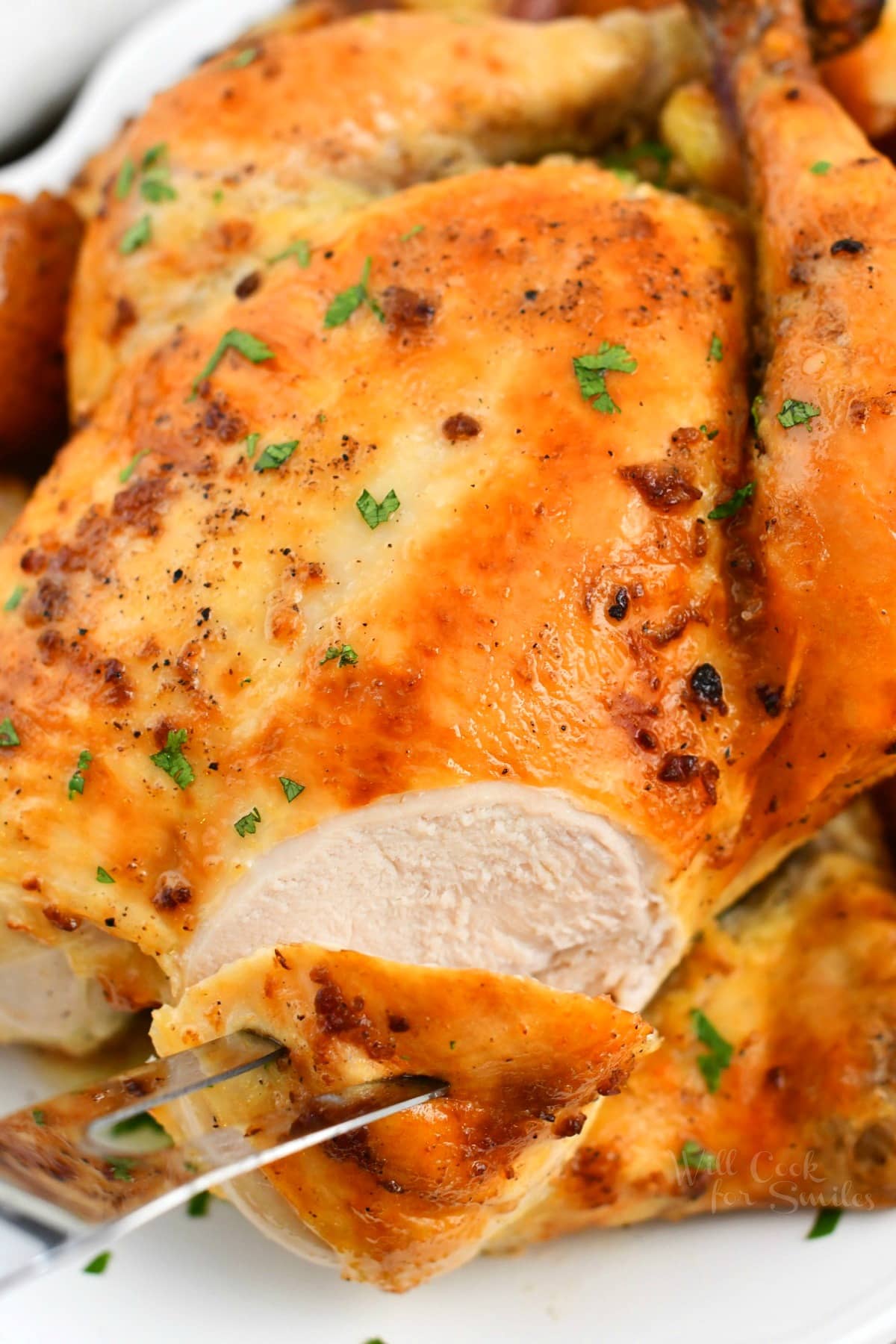
Storing and Reheating
Storing: Store leftover chicken in an airtight container in the refrigerator. You can break it down into smaller pieces for easier storage. Properly stored, it will last for about 3-4 days.
Reheating: With bone-in recipes like this one, I recommend reheating either in the oven or air fryer as opposed to the microwave. Both options will help maintain that crispy skin.
In the air fryer, I’d suggest breaking down the leftovers into breast, thighs, and drumsticks and reheating your leftovers at 360°F for about 4-5 minutes, but it also depends on size of the pieces. You may need a few more minutes if they’re very big. In the oven, I’d suggest 350°F for about 10 minutes, until heated through.
More Bone-In Chicken Recipes To Try
DID YOU MAKE THIS RECIPE? PLEASE leave a 🌟 star rating! Let me know how you liked it by leaving the 📝 comment below or share and tag me on social media @willcookforsmiles. DON’T FORGET to subscribe to my newsletter!

Roast Chicken Recipe
Ingredients
- 4-6 lb whole chicken
- 1/4 yellow onion
- 1/2 lemon
- 1 garlic bulb
- 4-5 sage leaves
- 3-4 sprigs of thyme
- 4 tbsp butter melted
- 4 garlic cloves
- salt
- black pepper
Instructions
- Preheat the oven to 425° and line a roasting pan with aluminum foil for easy clean-up.
Prepare chicken:
- Take chicken out of the package and rinse it off. Take out giblets and neck if it was included in the chicken. (You can discard it or use it making chicken stock.)
- Pat chicken dry with a paper towel.
- Cut off the very tip off the bulb of garlic to expose the garlic flesh.
- Season inside the cavity with salt and pepper. Don't be afraid, give it a good amount of seasoning.
- Insert half a lemon, quarter of an onion, garlic bulb, sage, and thyme into the cavity and tie the legs together with kitchen twine.
- In a small bowl, combine melted butter and pressed garlic cloves. Brush the chicken all around with garlic butter.
- Generously season the chicken all over with salt and pepper.
Roasting Chicken In The Oven:
- Place chicken into the prepared roasting pan and into the oven.
- Bake chicken for an hour and twenty minutes to an hour and a half, until the juices run clear.
- You can also check for doneness by using a digital read meat thermometer. Take the temperature in the center of the breast at the thickest part, but do not touch the bone. Internal temperature should be 165°.
- Take the chicken out of the oven, tent it with a sheet of foil loosely and let it rest for 10-15 minutes.
Adding vegetables:
- You can also add vegetables right into the roasting pan while chicken is cooking. Depending on the vegetables, you can add the half way trough or during the last 20-30 minutes of cooking.
- For potatoes: cut them into quarters or more, depending on the size, and toss with some canola oil, salt, pepper, and garlic powder. Spread potatoes in the roasting pan, all around the chicken, about half way through the cooking time.
- For carrots, onion, and celery: cut them and toss in some canola oil, salt, pepper, and garlic powder. Spread them in the roasting pan, all around the chicken, during the last 20-30 minutes. Thicken carrots will take a little longer to cook than thinner ones.
- If you want to mix potatoes and other vegetables, you would need to cut potatoes into smaller pieces so they cook through faster.
Notes
- Storing: Store leftover chicken in an airtight container in the refrigerator. You can break it down into smaller pieces for easier storage. Properly stored, it will last for about 3-4 days.
- Reheating: In the air fryer, I’d suggest breaking down the leftovers into breast, thighs, and drumsticks and reheating your leftovers at 360°F for about 4-5 minutes, but it also depends on size of the pieces. You may need a few more minutes if they’re very big. In the oven, I’d suggest 350°F for about 10 minutes, until heated through.
Nutrition
Originally published on Will Cook For Smiles in October, 2020.
All images and text ©Lyubov Brooke for ©Will Cook For Smiles. Please do not use my images without prior permission. If using my posts in collections and features, please link back to this post for the recipe.
Disclaimer: Nutrition information shown is not guaranteed to be 100% accurate as most ingredients and brands have variations.

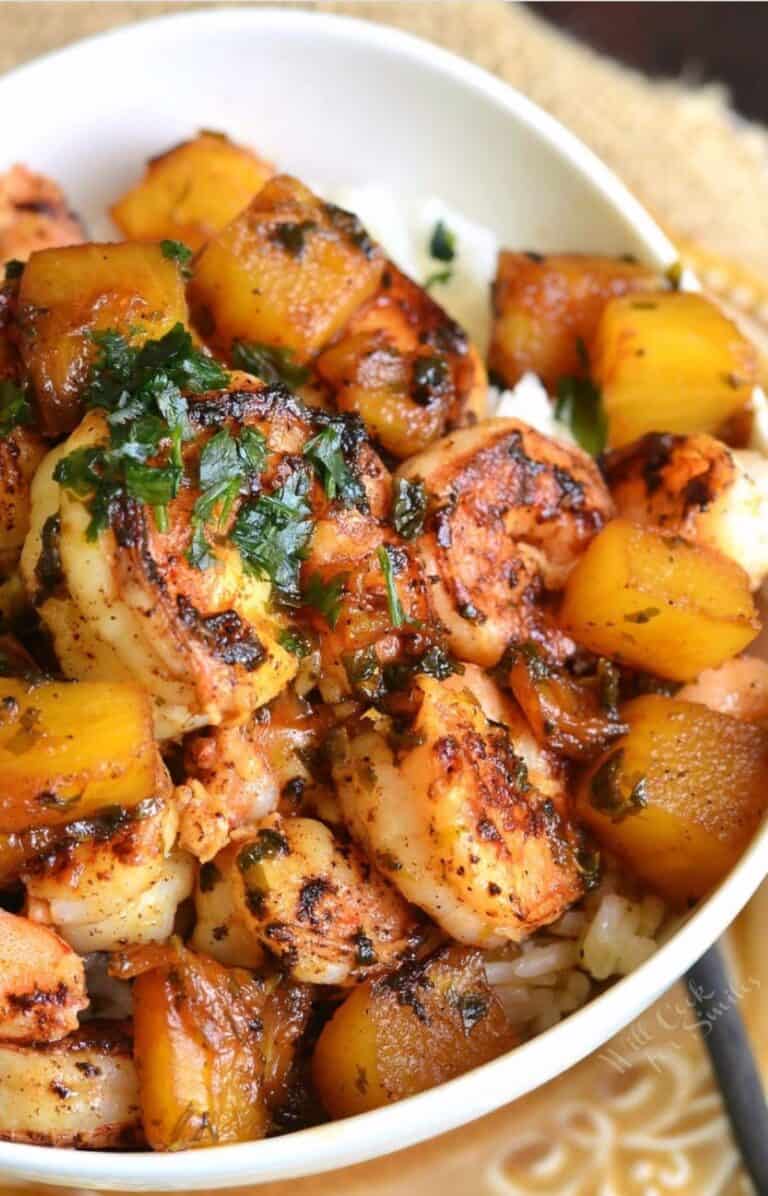
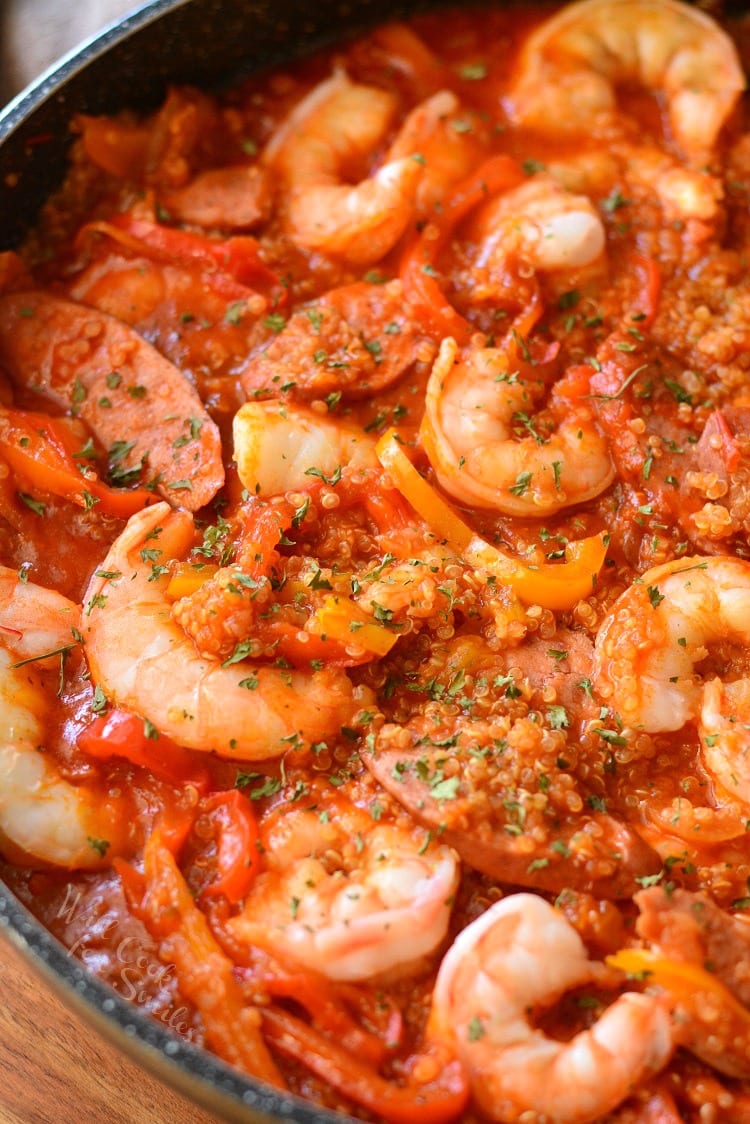
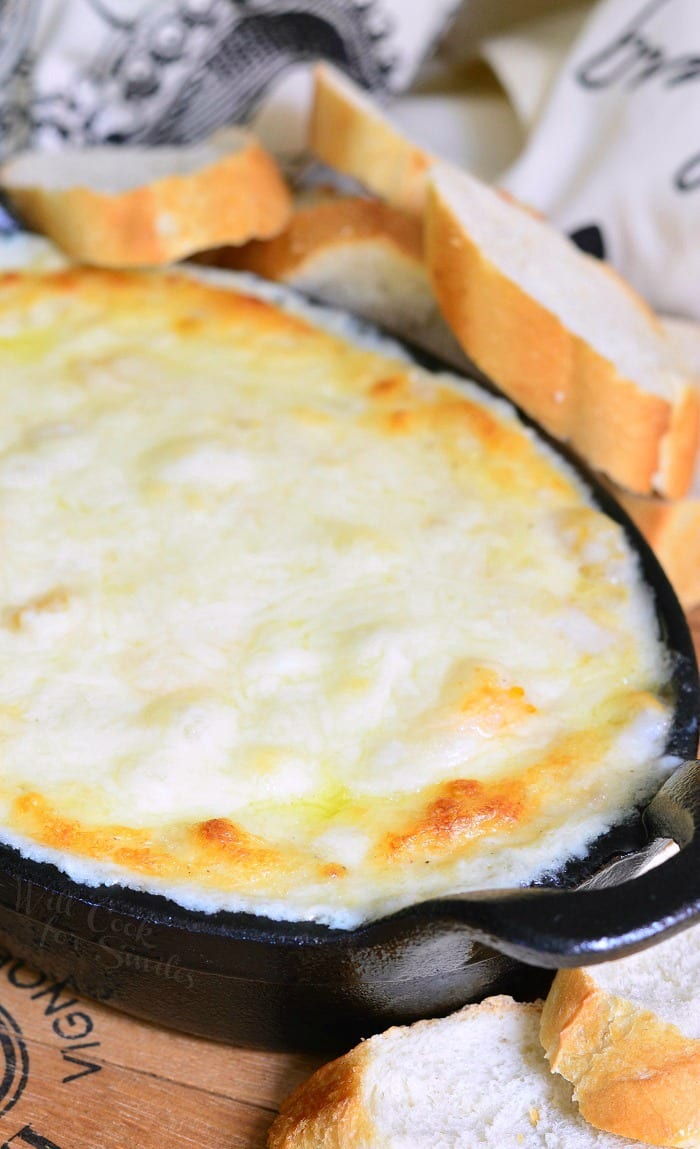
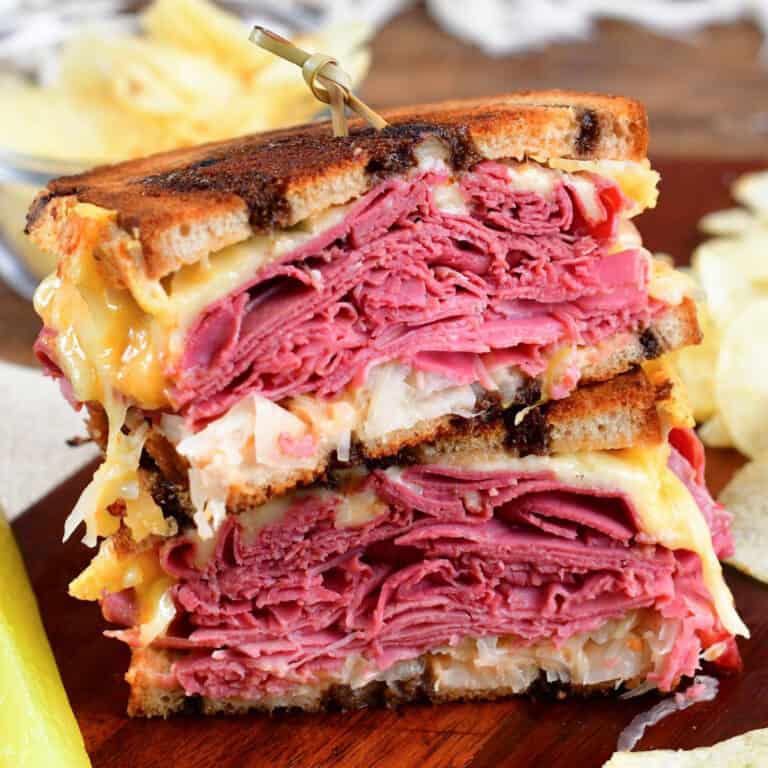
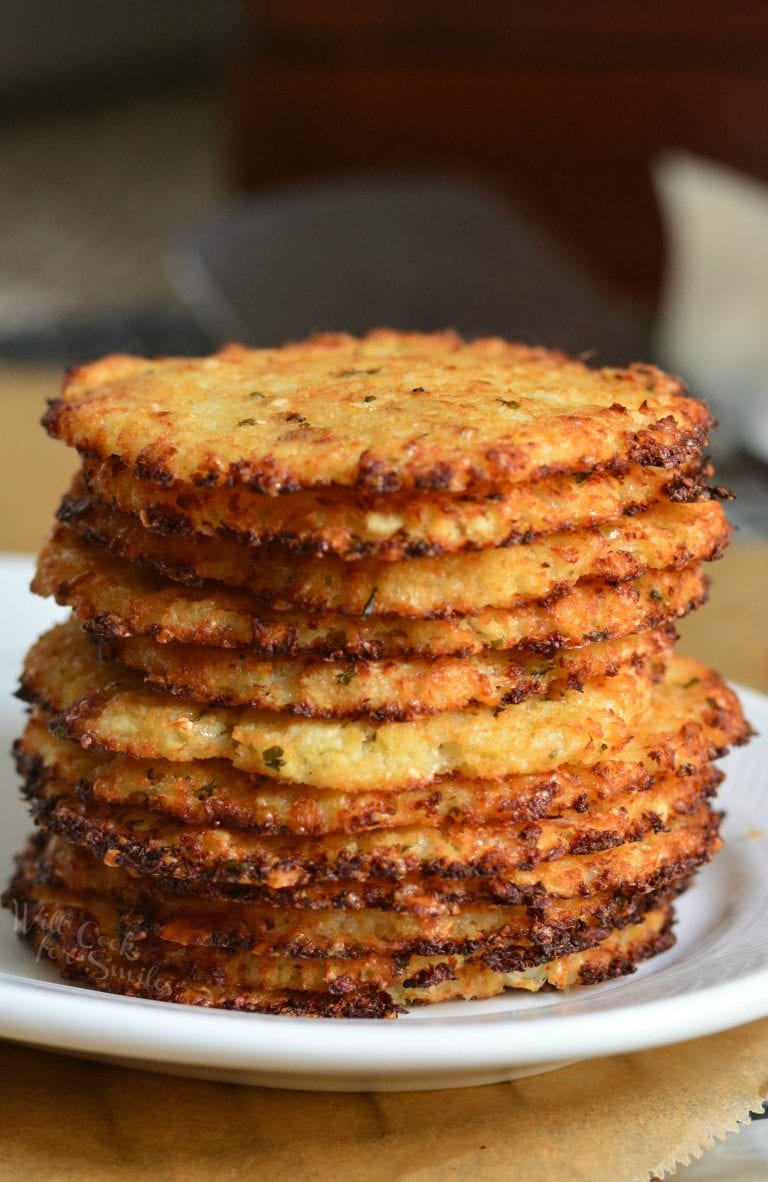








Hi. I roasted a chicken and I put aluminum foil on it and placed it in refrigerator for a day. I took it out and there was holes in the foil and the foil imprint on the chicken. I’m totally clueless as I’ve never seen this before. What do you think?
I am not sure what would’ve caused this but I would think it’s your foil. I would cool the chicken completely and maybe use a different foil.
Made this for a Sunday family dinner and everyone really liked it!